In the first test under Ian Foster’s reign as head coach, the All Blacks took a cautious approach, using many of the same concepts and plays they did when Foster was an assistant to Steve Hansen.
This was not unexpected. Although the players weren’t new, many were playing in new positions in their first test in nearly 12 months.
Jack Goodhue at 12, Rieko Ioane at 13, Jordie Barrett at 14 and Damian McKenzie returning at fullback for his first test since 2018 gave the All Blacks a completely foreign backline to the one used at the World Cup.
It made sense to stick with a menu of plays familiar to all. However, in difficult Wellington conditions that deteriorated as the game went on, this jack-of-all-trades backline didn’t quite click, and the Wallabies defence did a great job of nullifying the effectiveness of their strikes with a combination of smart, passive defence and blitzes.
In particular, rookie centre Hunter Paisami (13) was outstanding at perfectly executing a range of defensive tactics to keep Rieko Ioane (13) under control.
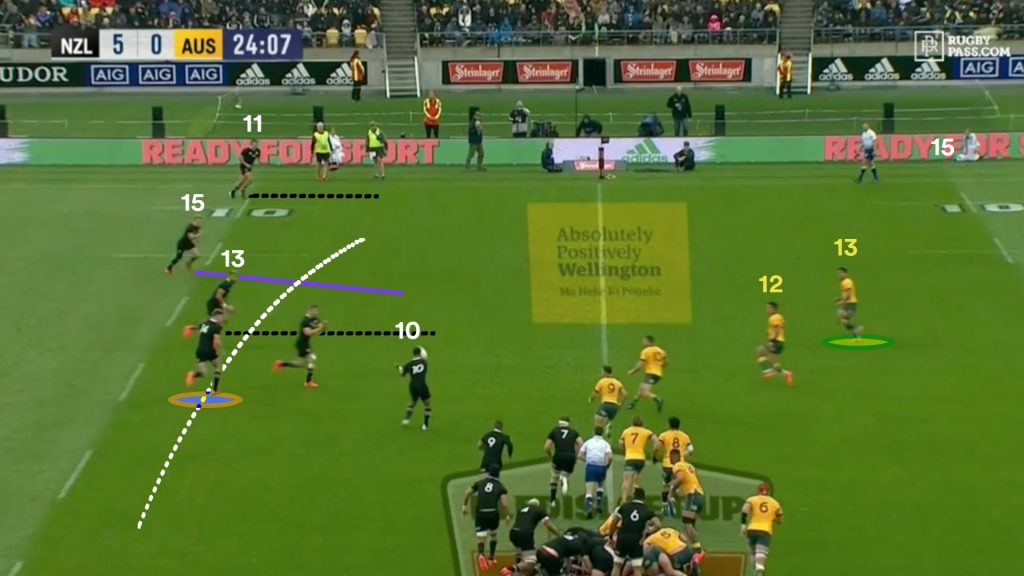
The ‘Miss 1 Sweep’ has been a staple play of the All Blacks under the Foster-Hansen regime, used frequently over the years but with notable success against Argentina in 2018 and Ireland last year at the World Cup.
The move sees early ball provided to the outside centre via a skip pass from the flyhalf, while the blind winger, Jordie Barrett (14) above, sweeps around the back to overload the edge outside the fullback. The fullback runs a hard angled option outside the centre to ‘freeze’ the last defender.
Against Ireland in the quarterfinal, New Zealand ran the play successfully when quick hands under pressure by Jack Goodhue put Sevu Reece in the clear on the outside. A phase later, the All Blacks scored with the Irish defence breached and scrambling.
Below, Beauden Barrett’s (15) hard line occupies the last defender Keith Earls (14), which allowed Reece to get around the corner at full speed.
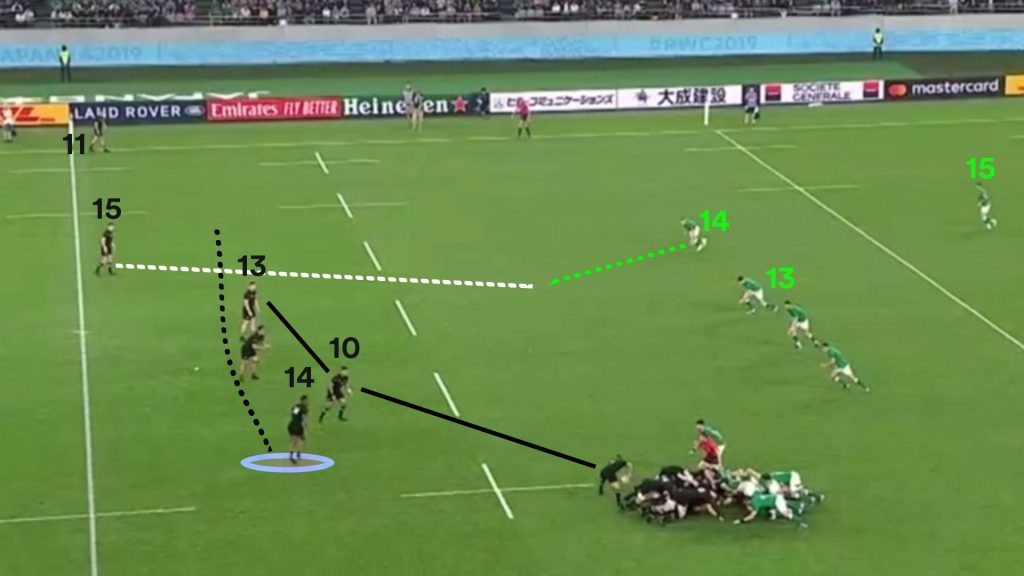

In the first test against the Wallabies, the play didn’t work nearly as well with new centre Rieko Ioane against the non-committal, in-to-out drift defence Australia used.
Hunter Paisami (13) did a great job playing ‘off’ Ioane, buying time for Matt Toomua (12) to slide across as the inside cover. Filipo Daugunu (14) also played deep, letting most of the All Blacks play unfold before ultimately shutting it down.
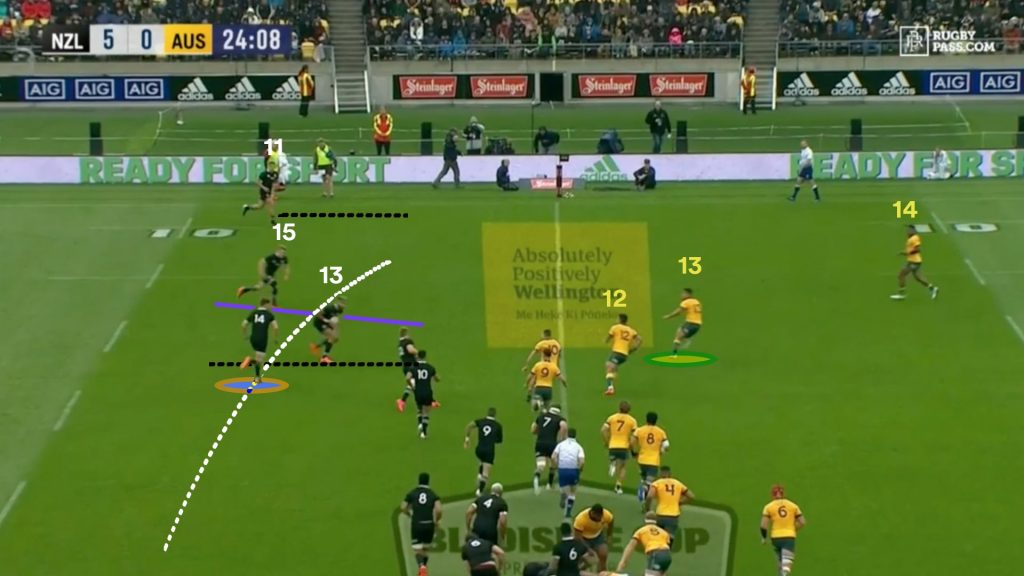
Faced with this passive jockey defence, Rieko Ioane tucked and ran to take the space on offer but, in doing so, missed the opportunity to play either McKenzie flat or Barrett out the back coming around the edge.
The Wallabies know Reiko Ioane is a serious running threat, but on this occasion he was unable to keep his options open late at the line, making the tackle easier for the defence. Once he decided to run, the defence had just one assignment and closed the attack down accordingly.
This passive approach by Dave Rennie’s side allowed easy metres to be made by the All Blacks as a trade off for better decision-making.
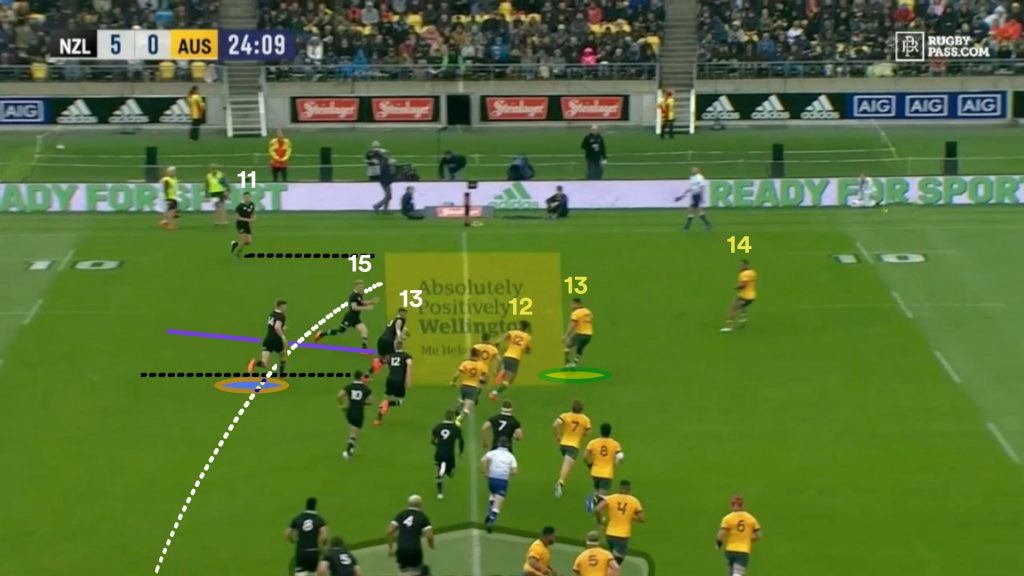
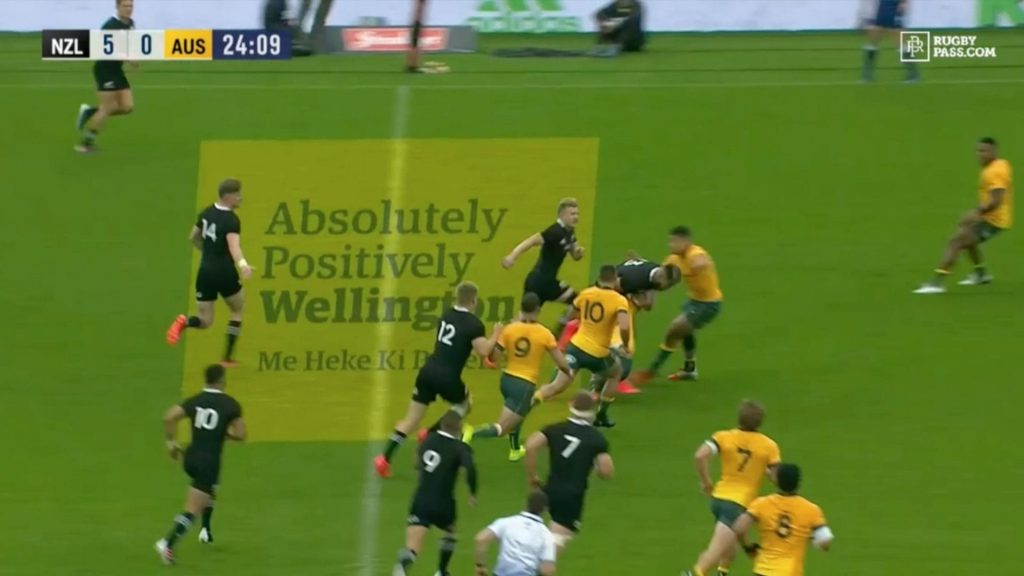
Matt Toomua chopped Ioane low and Paisami went high to prevent an offload being made to the free man Damian McKenzie.
The challenge for Rieko Ioane as a centre will be to fight his natural instincts of wanting to run and keeping his options open late when he does take the line on. With Daugunu playing deep, if the release had been made to Jordie Barrett once the Wallaby midfield was committed, the All Blacks would have had a golden opportunity to make a long break down the left side.
However, Ioane didn’t take the worst option either, as an early pass would have seen the Wallaby midfield continue to drift and push the All Blacks to the sideline.
It is a cat and mouse game that requires a nuanced touch that will develop with experience. Sometimes Ioane will face passive defence, sometimes a rush defence like Ireland, and the time to make the decision will vary.
Another old play on the All Blacks menu against the Wallabies was a commonly used out-ball, inside-ball concept behind a screen runner. This play can be traced back as far as Robbie Deans’ Wallabies side from 2010 when they beat the Springboks in South Africa. Multiple sides have adopted variations of it in the last decade and the All Blacks have used it with success in 2017 and 2018.
On the weekend, the All Blacks used Aaron Smith (9) as the first receiver in order to push Richie Mo’unga (10) into the playmaking role behind the screen run by Jack Goodhue (12).
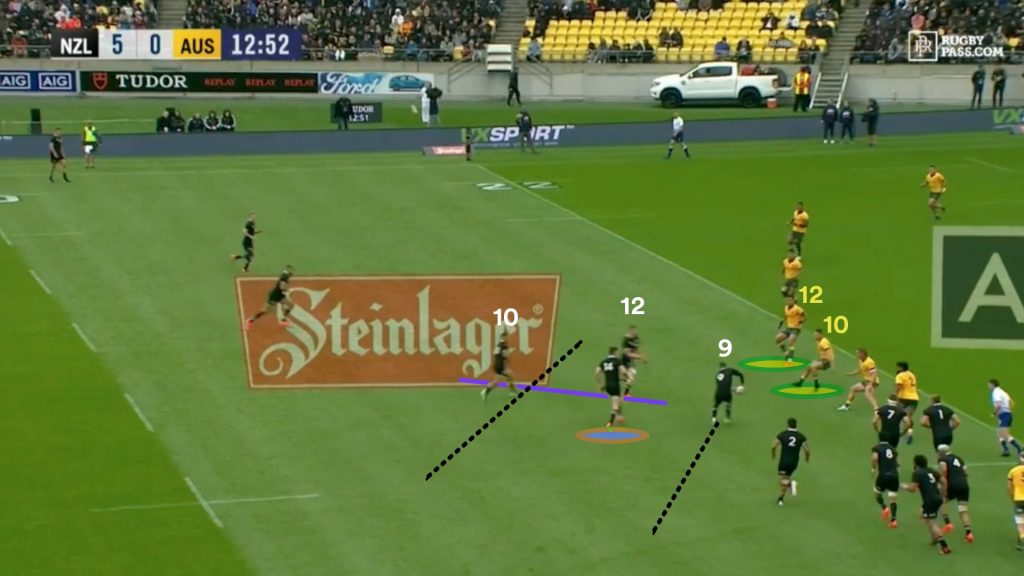
The play design aims to create separation in the Wallabies 10-12 channel, opening a gap for Jordie Barrett (14) to run through after receiving an inside ball from Mo’unga.
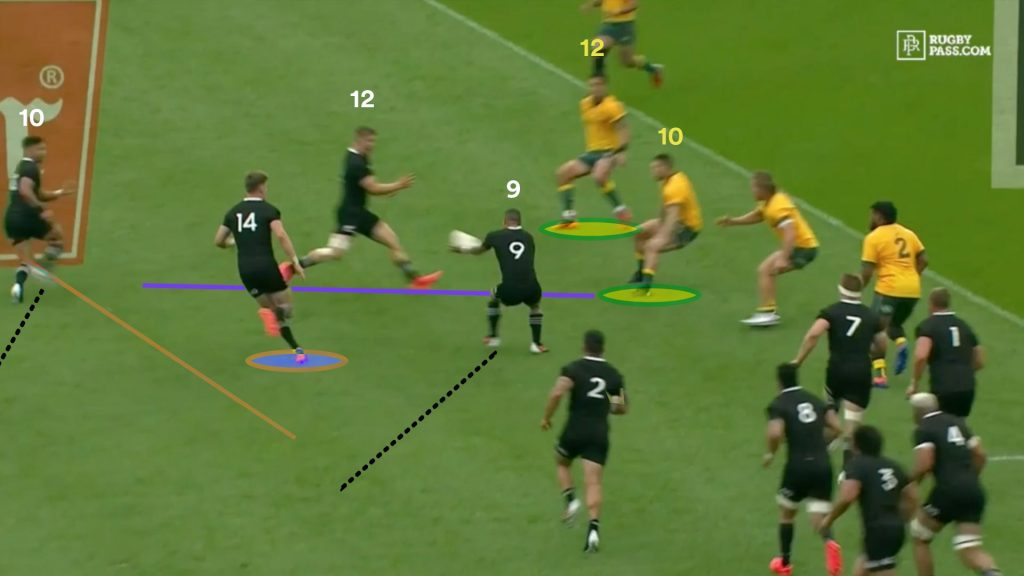
The Wallabies pushed up fast, but again pulled up passively to help identify the intended recipient and avoid bad commit decisions.
Makeshift wing Jordie Barrett was front-running Richie Mo’unga early in the play, a possible sign of his inexperience in the position.
It may have been deliberate, offering the picture to the Wallabies defence that he was an option for Aaron Smith, but equally shows the risk the All Blacks took moving men out of their natural position.
The precision needed at this level isn’t always there without specialists. The Wallabies have improved enough where you can’t get away with mistimed runs or passes. Playing Jordie Barrett, a fullback-centre who has played fewer than a handful of Super Rugby games on the wing, out of position in the 14 jersey in a test match does show a certain level of disrespect.
Jack Goodhue’s line checked James O’Connor momentarily, leaving the door open for Barrett but a great defensive read by Matt Toomua shut down the play.

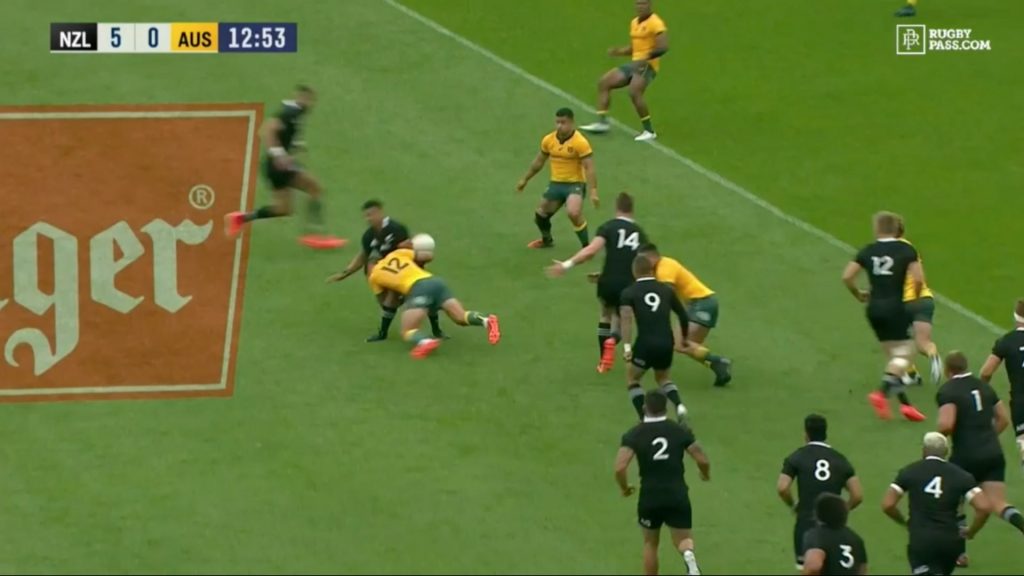
Toomua decelerated at first then charged forward once the recipient was identified to pressure Mo’unga. He made the hit to disrupt the pass before it could be made.
James O’Connor, originally checked by Goodhue, slid over and was able to cover the inside man Barrett anyway. It was great defence all-round, with excellent decision-making and execution. This is where the Wallabies backline defence excelled throughout the day, taking the time to identify the right man then close hard to stop the play.
When they made the read early, they were able to pressure Mo’unga, putting him under fire and knocking his passing game off-kilter.
This play has been used in the past often with Beauden Barrett at 10 to get quick ball to the wide channel. With two flat decoy options off 9, the 10 stays deep and becomes the link to the outside backs behind two ‘clear out’ lines.
The play rarely produced results on Sunday, however. In the below example, inside defenders James O’Connor and Matt Toomua have sat back on their heels but centre Hunter Paisami makes an early read that Mo’unga will be the link in the second level out the back.
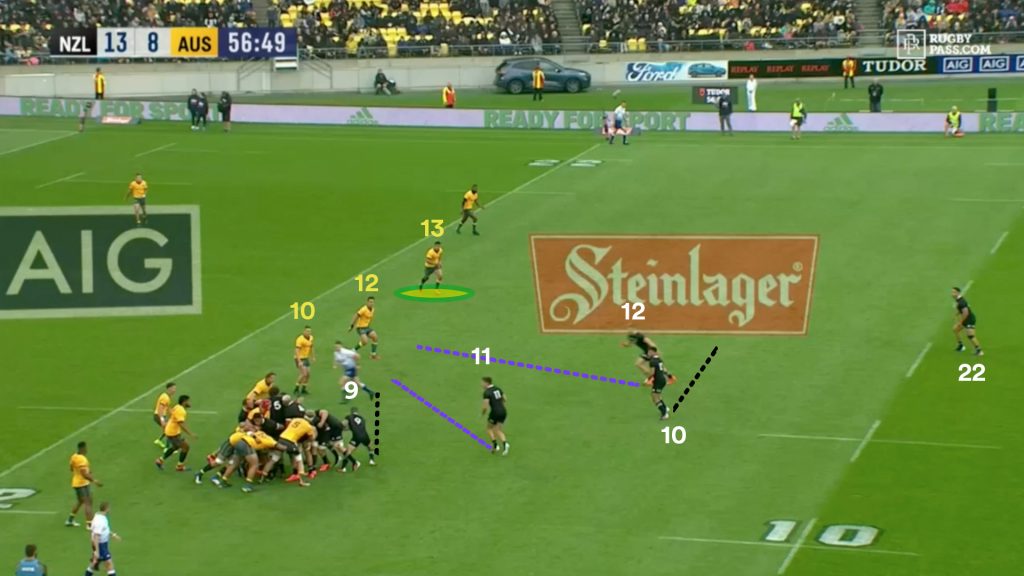
The early motion by Jack Goodhue (12) is the cue that Paisami took. He started to blitz Mo’unga even before Aaron Smith broke from the maul in a calculated gamble.
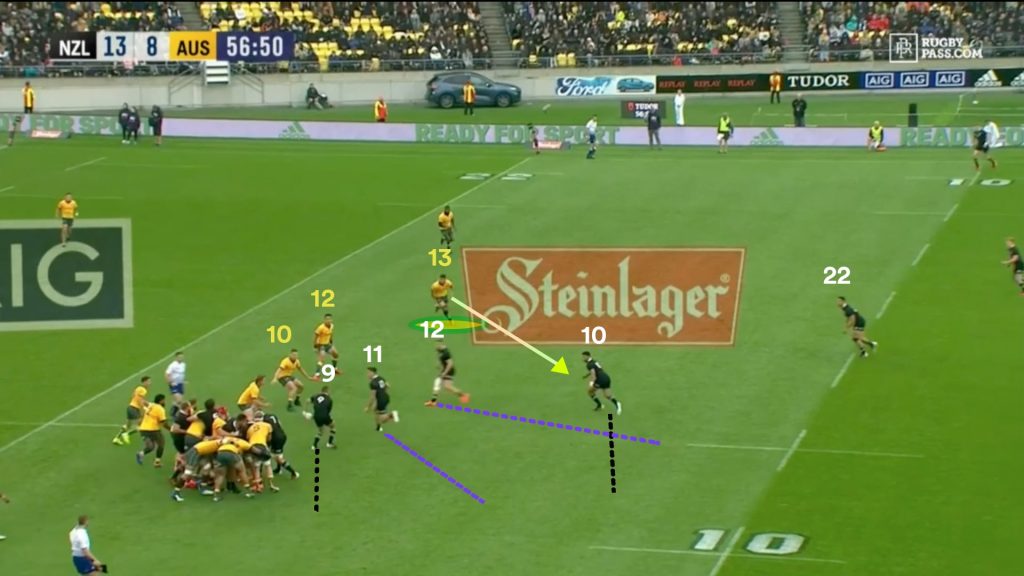
O’Connor and Toomua again played passive, holding to confirm that neither George Bridge (11) and Jack Goodhue (12) were targets before pushing out.
Paisami’s blitz is on the money and the pressure forces a rushed pass by the All Blacks 10. The pass hit Anton Lienert-Brown’s back shoulder and found the turf behind him.
This is the kind of mistake that the All Blacks usually force off the Wallabies, opening up their own counter-attack opportunities. This time, it was the Wallabies reversing the script.
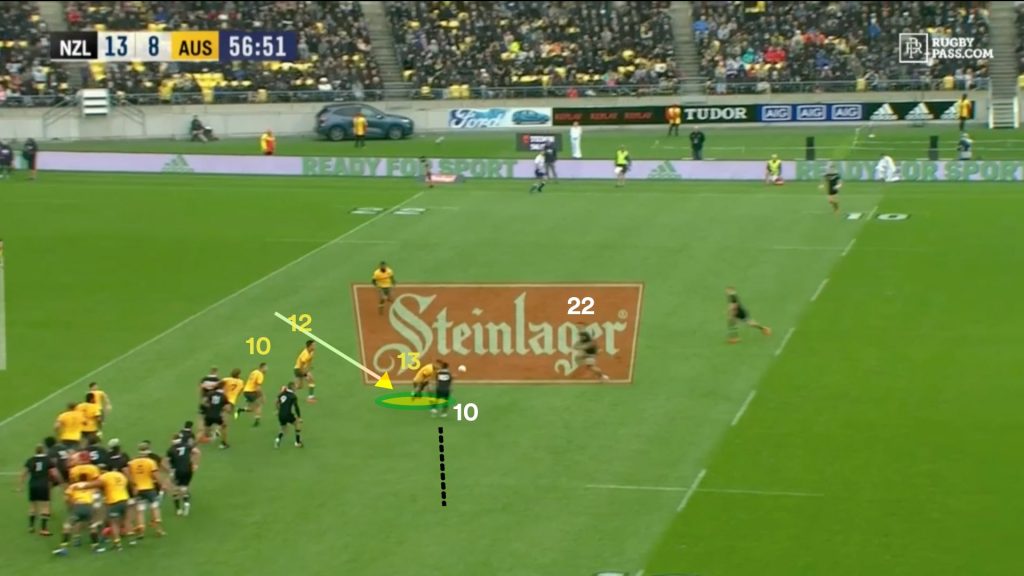
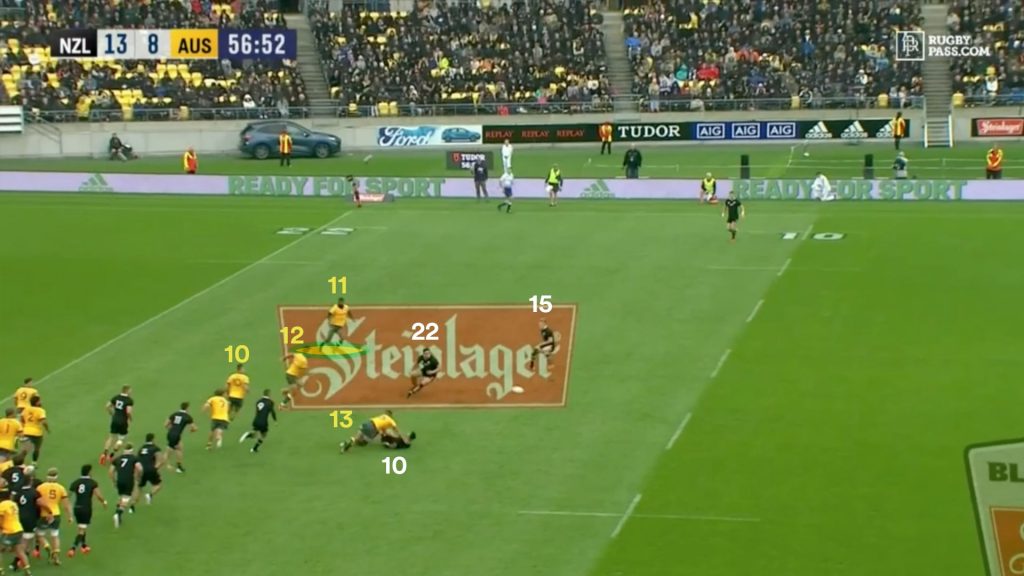
Marika Koroibete (11) was at hand to toe the ball ahead, resulting in a long Wallabies counter-attacking movement that set up an attacking possession deep inside the All Blacks’ half. Filipo Daugunu’s try comes a little while later off this swing in territory.
The one strike play that did work for the All Blacks was a Crusaders special from the line out, a sign of new assistant coach Brad Mooar’s influence.
This has been a highly successful line out strike play for the red and black machine over Scott Robertson’s tenure.
It was no surprise that three key Crusaders are involved, Codie Taylor, Joe Moody and George Bridge, who all know the details of this play inside and out. The hooker is sent on a ‘slingshot’ line around the maul after the throw, receiving a pop pass from the flanker playing halfback.
Once he is around the corner at pace, he has the winger as an inside option and the 12 as an outside option. At the back of the line out maul, the last lifter creates a seal by collapsing in and holding players in.
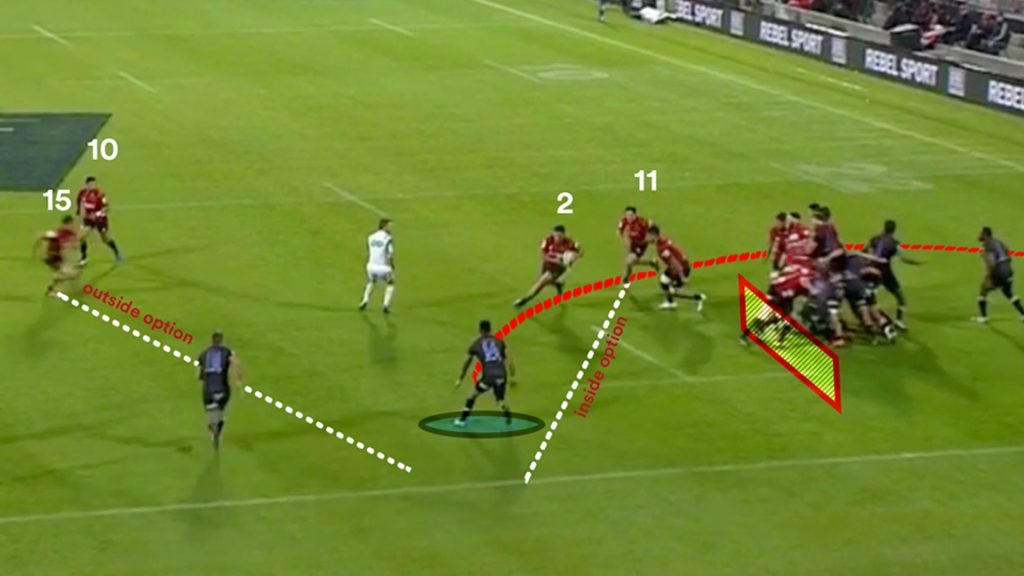
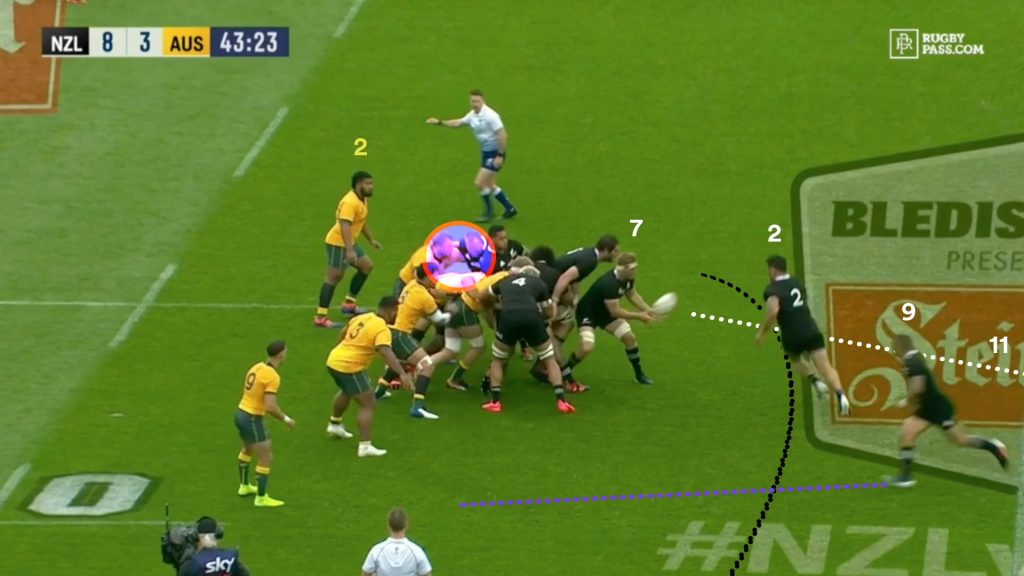
Above, we can see Joe Moody (1) has sealed off the edge with a hold on James Slipper as Codie Taylor makes the loop. This created the lane for George Bridge on the inside once Taylor drew the Wallabies tail defender Folau Fainga’a (2).
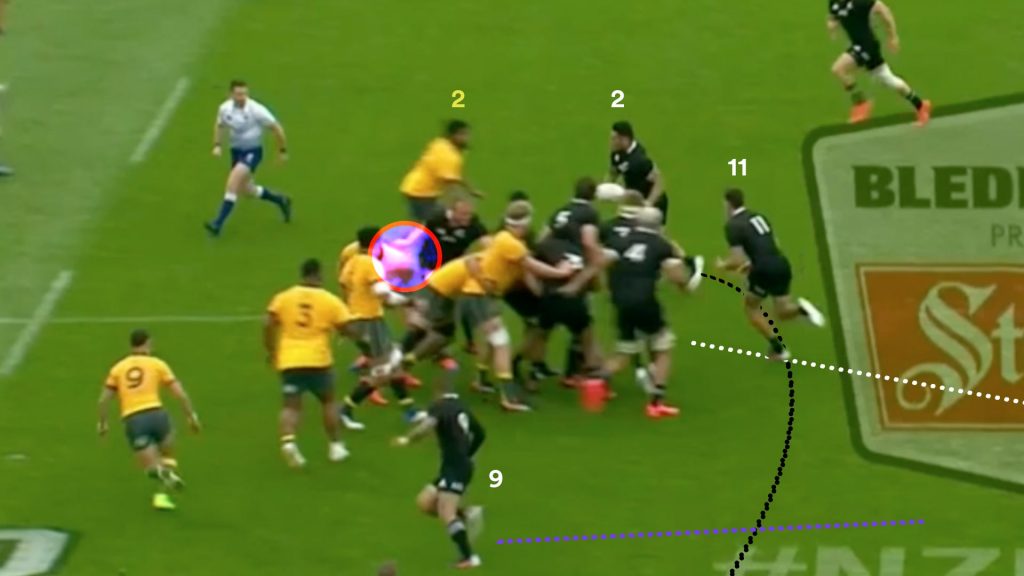
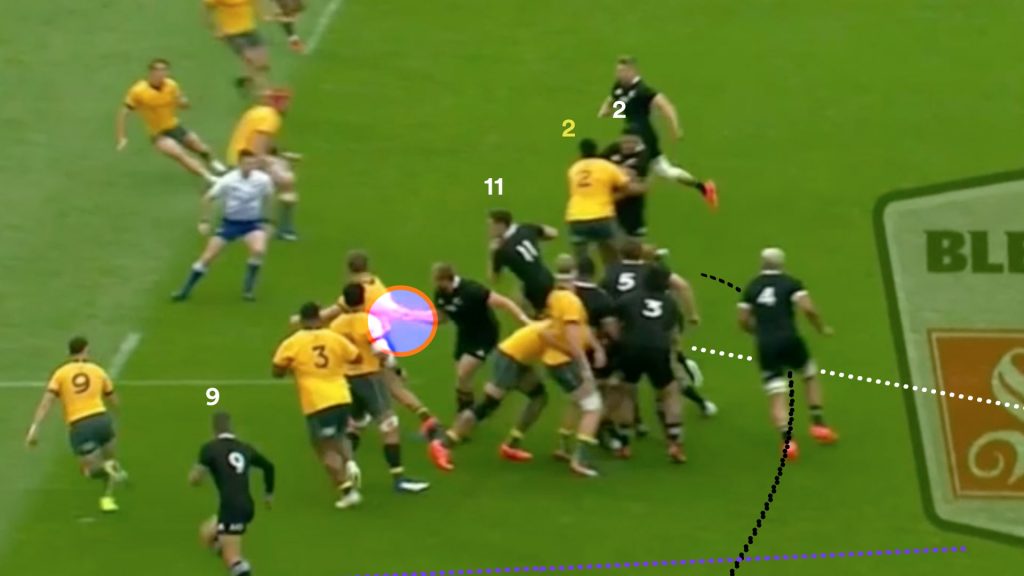
The dubious hold by Moody went unpunished and George Bridge sliced through untouched into the backfield. Aaron Smith (9) finished the movement after a one-on-one battle with his opposite Nic White.
The Wallabies backs held the All Blacks out only for the forwards to leak a set-piece try. It is interesting that the only play that worked was a Brad Mooar play rather than Foster’s regular set menu of strikes but credit has to be given to the Wallabies backline defence on this occasion, which was far more cohesive and disciplined than in years past.
With only 41% possession, most of the All Blacks day was spent tackling, leaving few opportunities from which to attack. A high turnover count from sloppy execution also hurt, as the Wallabies were able to control the match.
During phase play, the All Blacks still tried to use the ‘flush pod’ system from last season that uses two flat runners off 9 to draw interest before feeding the 10 deep in behind. The problem is the two runners rarely ever get used, making the pattern very predictable.
It has resulted in large gain line losses as the defence brings pressure outside the 10 to hammer his outside options. This has made it hard for Richie Mo’unga to shine, as the All Blacks continually go backward trying to get ‘around the defence’.
It has also removed a key strength the All Blacks possess, which is the ball-playing skills of their forward pack. With the two-man flush pod never getting the ball, the tip passing options are gone, making one less decision for the defensive line.
With a three-man pod getting the ball in front of Mo’unga, the forwards can take the initial heat from the defensive line and work Mo’unga into the game with the backdoor pass or tip options they are great at. During Super Rugby last season, the Crusaders had five of the top 10 forwards in line break assists, showing how much ball-playing the pack in front of Mo’unga was used to providing.
When Richie Mo’unga is playing off the back of front foot momentum, he can be very dangerous, as proven during Super Rugby Aotearoa, but that’s not happening under the All Blacks’ current system.
The relatively new shape is yet to really pay dividends after a year of use and has seen historically low output from the All Blacks attack in terms of points scored. This is the third game in 12 months that the All Blacks have failed to score 20 points against a Tier 1 team.
During the final nine minutes of extra time, the All Blacks did change up the pattern using far more direct carries off reserve halfback TJ Perenara with three-man pods heavily involved. Getting the likes of Hoskins Sotutu and Caleb Clarke involved gave the side an extra punch that had been missing, and they marched down the field to get in range for a final chance for the win.
In the second Bledisloe, the All Blacks may start to implement more changes to skew the balance back towards a system that leans on forward carries to generate some momentum for the backs to play off.
It doesn’t matter if Beauden Barrett or Richie Mo’unga is at 10 without a system change as both will continue to look average when forced to play behind gain line losses.
For the All Blacks to move on from the 2019 failure, they should do so by leaving the 2019 system behind and find a new way to maximise the talent at their disposal.



Comments
Join free and tell us what you really think!
Sign up for free